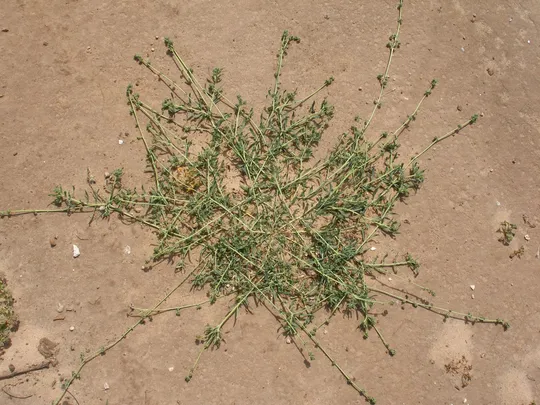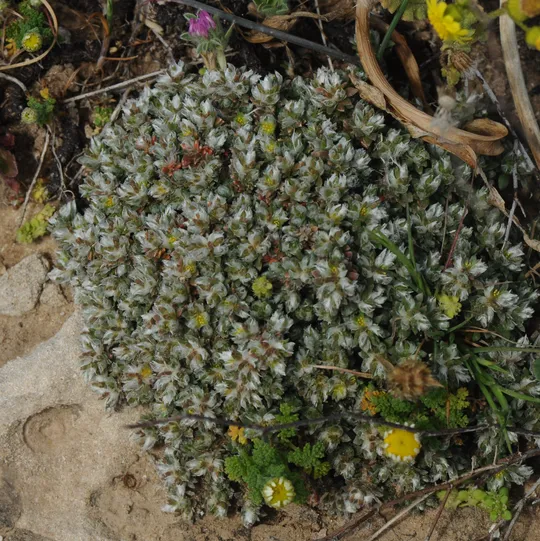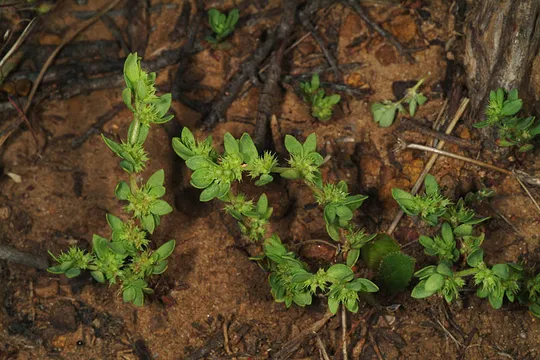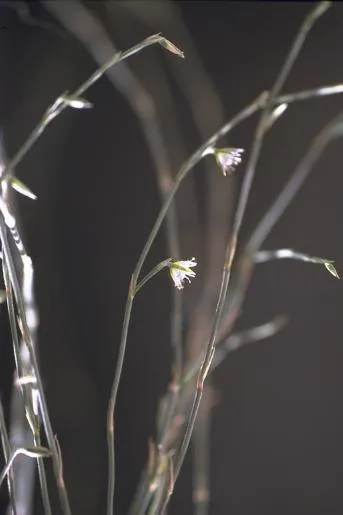Palestine Strapwort
Corrigiola palaestina


Corrigiola palaestina is now found at
two sites in the Sharon: the Menashe sedimentation reservoirs and the Dora Pond.
It is extinct from three sites and it is estimated that there are currently
four sites in the country. In the 1920s it was collected in En Hay (Kfar
Malal), Herzliya although it has become extinct from these sites.
Winter pools,
flooded heavy soils and water reservoirs on the coastal plain.
The genus Corrigiola belongs to
Paronychiinae sub-family which is part of the Caryophyllaceae
family. Most of the plants in this sub-family have tiny
stipules that accompany the regular leaves arranged in opposite pairs and fruits
that are hard nutlets containing a single seed. Corrigiola, however, has
alternate leaves arranged spirally around the stem and nutlets composed of
three carpels. This feature makes Corrigiola an unusual genus in the
group and suggest that it is ancient on the phylogenetic scale, as indeed the disjunct
distribution of the species in the genus (see below) indicates its antiquity.
Alternate leaves also exist in the Caryophyllaceae family in the genus
Telephium that is also considered an ancient genus. On the other hand,
the short life cycle of most of the species in the genus and their disturbed
habitats make them excellent migrants that crossed the Atlantic Ocean during the
last geological era, such as the genera Mesembryanthemom or Cakile
(Shmida 1985). Therefore, it is possible that we are actually discussing a
late-appearing species from the evolutionary point of view.
There are eight
genera and about 175 species in the Corrigiola genus group:
the genera Paronychia (108 species) and Herniaria (47 species)
are large genera, whereas Corrigiola has only 11 species. The other genera are endemic
ditypic (two species) or monotypic (a single species) that that are usually
found in disjunct and distant regions: one genus is monotypic and endemic to
the island of Socotra and the other is a monotypic genus endemic to Patagonia
in Argentina. In Israel the genera Gymnocarpos and Sclerocephalus
are known from this group, which have no related species. These facts support
the possibility that the entire sub-tribe to which Corrigiola belongs is actually ancient and
precedes the Pangaea continental breakdown. Chaudhri (1968) believes that the
group is an ancient tropical genus from which only the genus Gymnocarpos
deviates from to cold Central Asia (Mongolia). Zohary (1973), considers Gymnocarpos
(a woody plant with a three-valved fruit) the most ancient genus in the group.
The genus Corrigiola itself includes 11 species which have
an interesting disjunct distribution: seven species grow in the old world mainly
around the Mediterranean Basin, and four grow in South American Andes. Most of
the species grow in sandy habitats. The flowers in the genus are hermaphroditic
and protandrous. All the species in the genus have a hairy calyx similar to the
rest of the sub-family. The flower has three styles (in Gymnocarpos too),
while the remaining genera in the group have two. C.
palaestina is an
endemic species to Israel and Lebanon. The species similar to it is actually a
perennial from the Andes Mountains in South America. Zohari (1966) described this
taxon in the Flora Palaestina as a perennial subspecies of C. litoralis
– C. litoralis L. subsp. telephiifolia,
although in the monograph of the genus it is described as a new, annual,
species to science. This conflict regarding its life-form was resolved in favor
of Zohary’s opinion; field observations indicate that the plant is annual or
biennial: some of the specimens die after a year and some continue to exist for
another year, but most of the items in the population already flower during the
first season. C.palaestina is therefore identified as a separate species
from the annual C. litoralis. The two species differ in several features: C.
palaestina flowers are usually
grouped together at the ends of the stems, and most of the C.litoralis flowers are located in the
leaves' axils. Moreover, the two species grow in different habitats: C. palaestina grows in moist habitats whereas C.litoralis grows on sandy soils.
·
Corrigiola
palaestina is an extremely rare plant in Israel that grows in only
one region where it survived on two sites. It has become extinct from
additional sites where it was collected in the past. Most of the coastal winter
pools which are the primary habitat of C. palaestina have
disappeared. The main Israeli population, found in Dora Pond, is threatened by
the clearing and development taking place around it, which is likely to modify the
water regime at the site.
·
Both are located
within the boundaries of declared nature reserves. Dora Pond is only a proposed
nature reserve.
·
C. palaestina
is probably also endangered in Lebanon and may be extinct from there.
The Dora Pond should
be declared a nature reserve. This pool is home to many unique plant species,
some of them endangered (as well as typical winter pool animals). It is
important to maintain a suitable water regime in it and prevent its pollution
and development on its margins.
Corrigiola palaestina is endemic to
Israel and Lebanon. From Lebanon it is noted only from the region of Beirut and
has probably become extinct from there.
Corrigiola palaestina is an extremely rare annual herb of winter pools and flooded land. Its
habitat is disappearing and the remaining sites are very vulnerable. The
species is endemic to Israel and to the Lebanese coast.
Chaudhri M.N.1968, A revision of the Paronychiinae. Mededelingen van het Botanisch Museum en Herbarium van de Rijksuniversiteit te Utrecht, No.285
Current Occupancy Map
| 1000 squre meter pixel | 5000 squre meter pixel | 10000 squre meter pixel | |
|---|---|---|---|
| number of observations | 0 | 0 | 0 |
| in total pixels | 0 | 0 | 0 |
| Family | Caryophyllaceae |
| Classification | On the endangered species list |
| Ecosystem | Mediterranean humid |
| Chorotype | Mediterranean |
| Conservation Site | Dora Pond |
| Rarity |
1
5
6
|
|---|---|
| Vulnerability |
0
3
4
|
| Attractiveness |
0
0
4
|
| Endemism |
0
2
4
|
| Red number |
1
5.3
10
|
| Peripherality | 0 |
| IUCN category | DD EW EX LC CR EN VU NT |
| Threat Definition according to the red book | Critically endangered |
 Based on:
Based on:






